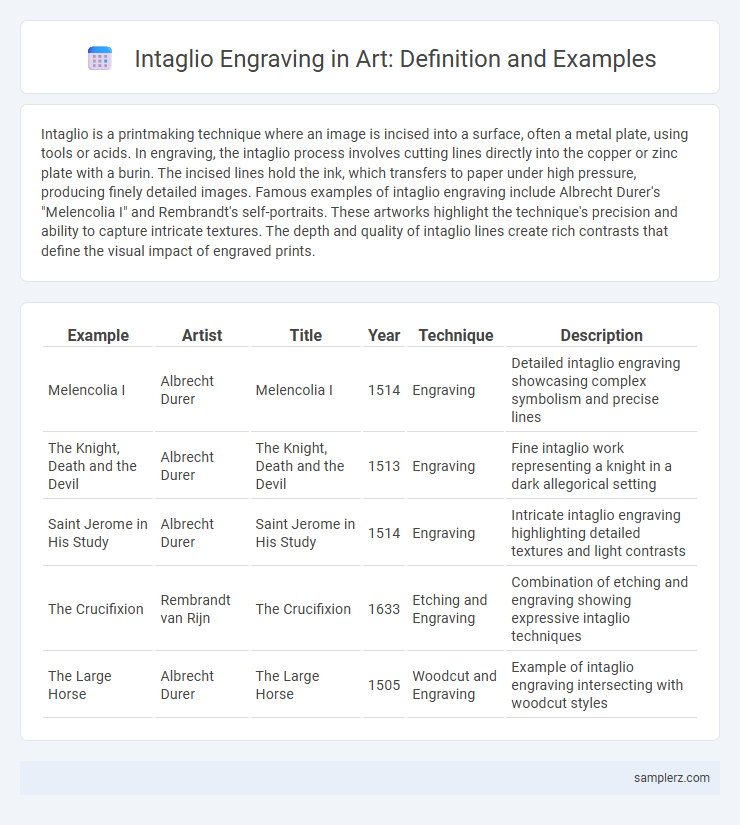Intaglio is a printmaking technique where an image is incised into a surface, often a metal plate, using tools or acids. In engraving, the intaglio process involves cutting lines directly into the copper or zinc plate with a burin. The incised lines hold the ink, which transfers to paper under high pressure, producing finely detailed images. Famous examples of intaglio engraving include Albrecht Durer's "Melencolia I" and Rembrandt's self-portraits. These artworks highlight the technique's precision and ability to capture intricate textures. The depth and quality of intaglio lines create rich contrasts that define the visual impact of engraved prints.
Table of Comparison
| Example | Artist | Title | Year | Technique | Description |
|---|---|---|---|---|---|
| Melencolia I | Albrecht Durer | Melencolia I | 1514 | Engraving | Detailed intaglio engraving showcasing complex symbolism and precise lines |
| The Knight, Death and the Devil | Albrecht Durer | The Knight, Death and the Devil | 1513 | Engraving | Fine intaglio work representing a knight in a dark allegorical setting |
| Saint Jerome in His Study | Albrecht Durer | Saint Jerome in His Study | 1514 | Engraving | Intricate intaglio engraving highlighting detailed textures and light contrasts |
| The Crucifixion | Rembrandt van Rijn | The Crucifixion | 1633 | Etching and Engraving | Combination of etching and engraving showing expressive intaglio techniques |
| The Large Horse | Albrecht Durer | The Large Horse | 1505 | Woodcut and Engraving | Example of intaglio engraving intersecting with woodcut styles |
Introduction to Intaglio Engraving
Intaglio engraving, a traditional printmaking technique, involves incising designs into a metal plate, usually copper or zinc, using sharp tools or acid. This method allows for fine, detailed lines and rich textural effects, making it ideal for intricate images and high-quality prints. Artists like Albrecht Durer and Rembrandt popularized intaglio for its precision and depth, significantly influencing the evolution of graphic arts.
Historical Origins of Intaglio Techniques
Intaglio engraving, emerging during the Renaissance, originated as a method for creating detailed images on metal plates, primarily copper, by incising lines to hold ink. Pioneered by artists like Albrecht Durer in the 15th century, intaglio became fundamental in printmaking, combining precision and depth rarely seen in earlier relief methods. This technique advanced through centuries, influencing art reproduction and illustrating the evolution from simple etching to complex drypoint and mezzotint processes.
Famous Artists Who Used Intaglio Engraving
Albrecht Durer, a master of Renaissance art, is renowned for his intricate intaglio engravings that emphasized fine detail and tonal variation using copper plates. Rembrandt van Rijn utilized intaglio techniques, particularly etching and drypoint, to create expressive and atmospheric prints that captured human emotion. Francisco Goya employed intaglio engraving to produce powerful social and political commentaries in his series "Los Caprichos," showcasing the medium's capacity for dramatic contrast and texture.
Notable Intaglio Prints in Art History
Notable intaglio prints in art history include Albrecht Durer's "Melencolia I" (1514), showcasing intricate etching and engraving techniques that highlight detailed textures and elaborate symbolism. Rembrandt van Rijn's "The Three Crosses" (1653) stands out for its masterful use of drypoint and etching, producing dramatic contrasts and depth in religious narrative scenes. Francisco Goya's "Los Caprichos" series (1797-1798) exemplifies intaglio's ability to combine social commentary with expressive line work and tonal variation.
Classic Examples of Line Engraving
Classic examples of line engraving as an intaglio technique include Albrecht Durer's meticulously detailed prints such as "Melencolia I" and "Knight, Death, and the Devil," which showcase precise linear incisions on copper plates. Another significant example is William Hogarth's satirical series "A Rake's Progress," demonstrating intricate line work that conveys narrative and texture through engraved lines. These masterpieces reflect the hallmark of intaglio engraving characterized by fine lines incised into metal plates to create depth and tonal variation.
Iconic Mezzotint Intaglio Works
Iconic mezzotint intaglio works like Rembrandt's "Christ Crucified Between Two Thieves" showcase the rich tonal range and deep contrast achievable through this technique. The mezzotint process involves roughening the plate surface to hold ink, allowing artists to create smooth gradations from dark shadows to light highlights. This method remains celebrated for its ability to produce dramatic, highly detailed engravings with a unique velvety texture.
Renowned Aquatint Intaglio Examples
Renowned aquatint intaglio examples include Francisco Goya's "Los Caprichos," which masterfully combines tonal variations and fine lines to depict social satire. The technique involves etching a metal plate with acid to create subtle gradations of shading, allowing for rich textures and depth. Aquatint's ability to render atmospheric effects made it a favored method among 18th and 19th-century printmakers for expressive and detailed artwork.
Contemporary Intaglio Engraving Pieces
Contemporary intaglio engraving pieces often showcase intricate line work and deep textural contrasts, exemplified by artists like Kiki Smith and Julie Mehretu. These works utilize techniques such as etching, drypoint, and aquatint to achieve rich tonal variations and dynamic compositions. The fusion of traditional intaglio methods with modern themes and materials redefines the boundaries of printmaking in the 21st century.
Museum Collections Featuring Intaglio Engravings
Museum collections featuring intaglio engravings prominently include institutions like the British Museum, which houses extensive prints by masters such as Albrecht Durer and Rembrandt. The Metropolitan Museum of Art showcases Renaissance and Baroque intaglios, emphasizing the detailed recessed designs characteristic of this technique. These collections highlight the intricate process of incising images into metal plates, preserved as cultural heritage across centuries.
Influence of Intaglio Engraving on Modern Art
Intaglio engraving, a printmaking technique involving incised lines on metal plates, has profoundly influenced modern art by enabling artists to achieve exceptional detail and texture in their works. Pioneers like Albrecht Durer and Francisco Goya demonstrated its capacity for dramatic contrasts and expressive line work, inspiring contemporary artists to explore complex visual narratives and abstract forms. The method's adaptability continues to shape experimental printmaking, merging traditional craftsmanship with innovative artistic concepts in modern visual culture.

example of intaglio in engraving Infographic
 samplerz.com
samplerz.com